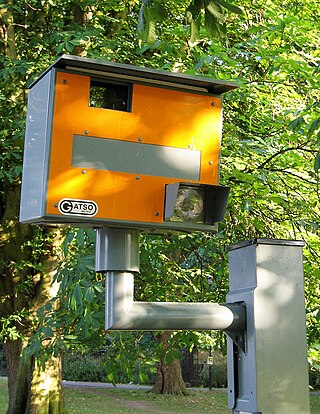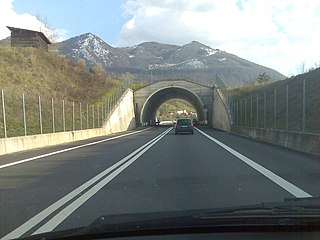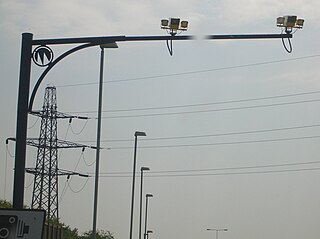
Truvelo Combi is a speed camera manufactured by the South African company Truvelo Manufacturers (Pty) Ltd. [1] It was approved in 1999. [2]

Truvelo Combi is a speed camera manufactured by the South African company Truvelo Manufacturers (Pty) Ltd. [1] It was approved in 1999. [2]
The Truvelo camera is usually a front-facing camera (it can also be rear-facing) taking pictures using a flash gun fitted with a magenta filter [3] (the driver is less likely to be dazzled by the flash light). The reflected light provides the film with the correct exposure resulting in a clear picture of the driver committing the offence (considered as incriminating evidence).
Piezo-electric road strips, a known distance apart (1.53 cm from 1 - 3, 2 - 4) are set into the road in front of the camera, and the time between compressions is measured using an impededance converter and two clocks in the camera to give the resulting speed of the vehicle. The system takes a single photograph (front-facing only, two for rear photography) and uses the time from the clocks to calculate the resulting speed. The photograph of the offending vehicle will show its front tyres on the three narrowly spaced white lines across the carriageway (known as a Secondary Speed Check Lines), the middle line is 1.8 m from the last sensor, the first and third are 18 cm either side of the middle line = 10% [4] which are present at all Truvelo installations. This is to identify the offending vehicle when it is travelling alongside a non-offending one.
For front-facing photography there are two sets of Piezo sensors that are linked as 1 - 3 and 2 - 4 in the road for Truvelo camera, both taking independent readings, if the two do not match (±2 mph) the offence is discarded. [5]
In the United Kingdom, the single incriminating photograph will not be sent unless the car owner asks for it – a Home Office ruling aimed at avoiding embarrassing situations if a driver is photographed with someone they would prefer not to be seen with. Not all Safety Camera Partnerships will disclose picture evidence. Some will only issue copies of the original photos once a summons for court has been issued, and there is a need to comply with disclosure rules.

A traffic enforcement camera is a camera which may be mounted beside or over a road or installed in an enforcement vehicle to detect motoring offenses, including speeding, vehicles going through a red traffic light, vehicles going through a toll booth without paying, unauthorized use of a bus lane, or for recording vehicles inside a congestion charge area. It may be linked to an automated ticketing system.

Traffic lights, traffic signals, or stoplights – known also as robots in South Africa – are signalling devices positioned at road intersections, pedestrian crossings, and other locations in order to control flows of traffic.

A flash is a device used in photography that produces a brief burst of light at a color temperature of about 5500 K to help illuminate a scene. A major purpose of a flash is to illuminate a dark scene. Other uses are capturing quickly moving objects or changing the quality of light. Flash refers either to the flash of light itself or to the electronic flash unit discharging the light. Most current flash units are electronic, having evolved from single-use flashbulbs and flammable powders. Modern cameras often activate flash units automatically.

Gatso is the brand that Gatsometer BV use on their speed cameras and red light cameras. The most commonly encountered Gatso speed cameras emit radar beams to measure the speed of a passing vehicle. If it is travelling above the preset trigger speed, one or two photographs are taken. These use a powerful flash, to show the rear of the vehicle, its registration plate, and calibration lines on the road. Newer installations used digital cameras which have limited exposure latitude compared to film, these installations use an auxiliary flash placed close to the position where a speeding vehicle would exit the radar beam and the first photograph would be taken.

Macro photography is extreme close-up photography, usually of very small subjects and living organisms like insects, in which the size of the subject in the photograph is greater than life size . By the original definition, a macro photograph is one in which the size of the subject on the negative or image sensor is life size or greater. In some senses, however, it refers to a finished photograph of a subject that is greater than life size.

A traffic ticket is a notice issued by a law enforcement official to a motorist or other road user, indicating that the user has violated traffic laws. Traffic tickets generally come in two forms, citing a moving violation, such as exceeding the speed limit, or a non-moving violation, such as a parking violation, with the ticket also being referred to as a parking citation, or parking ticket.

A red light camera is a type of traffic enforcement camera that photographs a vehicle that has entered an intersection after the traffic signal controlling the intersection has turned red. By automatically photographing vehicles that run red lights, the photo is evidence that assists authorities in their enforcement of traffic laws. Generally the camera is triggered when a vehicle enters the intersection after the traffic signal has turned red.

In road-transport terminology, a lane departure warning system (LDWS) is a mechanism designed to warn the driver when the vehicle begins to move out of its lane on freeways and arterial roads. These systems are designed to minimize accidents by addressing the main causes of collisions: driver error, distractions and drowsiness. In 2009 the U.S. National Highway Traffic Safety Administration (NHTSA) began studying whether to mandate lane departure warning systems and frontal collision warning systems on automobiles.

A radar detector is an electronic device used by motorists to detect if their speed is being monitored by police or law enforcement using a radar gun. Most radar detectors are used so the driver can reduce the car's speed before being ticketed for speeding. In general sense, only emitting technologies, like doppler RADAR, or LIDAR can be detected. Visual speed estimating techniques, like ANPR or VASCAR can not be detected in daytime, but technically vulnerable to detection at night, when IR spotlight is used. There are no reports that piezo sensors can be detected. LIDAR devices require an optical-band sensor, although many modern detectors include LIDAR sensors. Most of today's radar detectors detect signals across a variety of wavelength bands: usually X, K, and Ka. In Europe the Ku band is common as well. The past success of radar detectors was based on the fact that radio-wave beams can not be narrow-enough, so the detector usually senses stray and scattered radiation, giving the driver time to slow down. Based on a focused laser-beam, LIDAR technology does not suffer this shortcoming; however it requires precise aiming. Modern police radars incorporate formidable computing power, producing a minimum number of ultra-short pulses, reusing wide beams for multi-target measurement, which renders most detectors useless. But, mobile Internet allows GPS navigation devices to map police radar locations in real-time. These devices are also often called "radar detectors", while not necessary carrying an RF sensor.

The Škoda Fabia is a mini car produced by Czech manufacturer Škoda Auto since 1999. It is the successor of the Škoda Felicia, which was discontinued in 2001. The Fabia was available in hatchback, estate and saloon body styles at launch, and since 2007, the second generation is offered in hatchback and estate versions. The third generation Fabia was launched in 2015, and the fourth in 2021.

Intelligent Parking Assist System (IPAS), also known as Advanced Parking Guidance System (APGS) for Toyota models in the United States, is the first production automatic parking system developed by Toyota Motor Corporation in 1999 initially for the Japanese market hybrid Prius models and Lexus models. The technology assists drivers in parking their vehicle. On vehicles equipped with the IPAS, via an in-dash screen and button controls, the car can steer itself into a parking space with little input from the user. The first version of the system was deployed on the Prius Hybrid sold in Japan in 2003. In 2006, an upgraded version debuted for the first time outside Japan on the Lexus LS luxury sedan, which featured the automatic parking technology among other brand new inventions from Toyota. In 2009, the system appeared on the third generation Prius sold in the U.S. In Asia and Europe, the parking technology is marketed as the Intelligent Park Assist System for both Lexus and Toyota models, while in the U.S. the Advanced Parking Guidance System name is only used for the Lexus system.

The Škoda Octavia is a small family car produced by the Czech car manufacturer Škoda Auto since the end of 1996. It shares its name with an earlier model produced between 1959 and 1971. Four generations of the modern-era Octavia model have been introduced to date, delivered with five-door liftback or five-door estate styles only. The car is front engined, both front- or four-wheel drive are offered. Around five million units have been sold in its two decades of presence on the market. The Octavia is Škoda's most popular model; about 40% of all newly manufactured Škoda cars are Octavias.
Road speed limit enforcement in Australia constitutes the actions taken by the authorities to force road users to comply with the speed limits in force on Australia's roads. Speed limit enforcement equipment such as speed cameras and other technologies such as radar and LIDAR are widely used by the authorities. In some regions, aircraft equipped with VASCAR devices are also used.

Adaptive cruise control (ACC) is an available cruise control advanced driver-assistance system for road vehicles that automatically adjusts the vehicle speed to maintain a safe distance from vehicles ahead. As of 2019, it is also called by 20 unique names that describe that basic functionality. This is also known as Dynamic cruise control.

d-cam is a type of digital speed camera produced by the British subsidiary of the South African company Truvelo Manufacturers (Pty) Ltd. Testing by Transport for London commenced on the A4 Great West Road in London, in April 2007. The camera does not flash and can be used rear or forward-facing. It was the first combined traffic light camera and speed camera to be used in the United Kingdom. The new style of camera housing was designed by Bristol-based firm Crown (UK) Ltd.

A collision avoidance system (CAS), also known as a pre-crash system, forward collision warning system, or collision mitigation system, is an advanced driver-assistance system designed to prevent or reduce the severity of a collision. In its basic form, a forward collision warning system monitors a vehicle's speed, the speed of the vehicle in front of it, and the distance between the vehicles, so that it can provide a warning to the driver if the vehicles get too close, potentially helping to avoid a crash. Various technologies and sensors that are used include radar (all-weather) and sometimes laser (LIDAR) and cameras to detect an imminent crash. GPS sensors can detect fixed dangers such as approaching stop signs through a location database. Pedestrian detection can also be a feature of these types of systems.

Headlight flashing is the act of either briefly switching on the headlights of a car, or of momentarily switching between a headlight's high beams and low beams, in an effort to communicate with another driver or drivers. The signal is sometimes referred to in car manufacturers' manuals as an optical horn, since it draws the attention of other drivers.

Speed limits are enforced on most public roadways by authorities, with the purpose to improve driver compliance with speed limits. Methods used include roadside speed traps set up and operated by the police and automated roadside 'speed camera' systems, which may incorporate the use of an automatic number plate recognition system. Traditionally, police officers used stopwatches to measure the time taken for a vehicle to cover a known distance. More recently, radar guns and automated in-vehicle systems have come into use.

Road speed limit enforcement in the United Kingdom is the action taken by appropriately empowered authorities to attempt to persuade road vehicle users to comply with the speed limits in force on the UK's roads. Methods used include those for detection and prosecution of contraventions such as roadside fixed speed cameras, average speed cameras, and police-operated LIDAR speed guns or older radar speed guns. Vehicle activated signs and Community Speed Watch schemes are used to encourage compliance. Some classes of vehicles are fitted with speed limiters and intelligent speed adaptation is being trialled in some places on a voluntary basis.
O'Halloran and Francis v. United Kingdom was a 2007 European Court of Human Rights case. The case revolved around a challenge to a requirement in the United Kingdom's Road Traffic Act 1988 that owners of a speeding vehicle provide police with the name of the driver. The plaintiffs, two British citizens, argued that the requirement was a violation of Article 6 of the European Convention on Human Rights, under which there exists an implied right to remain silent. In a departure from previous rulings on the issue, the court ruled in a 15–2 majority that the Road Traffic Act requirement was not unreasonable and that there was therefore no Human Rights violation.
{{cite web}}: CS1 maint: archived copy as title (link)